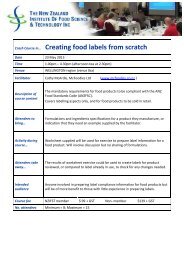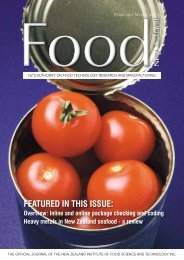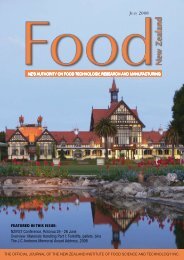featured in this issue - NZIFST - The New Zealand Institute of Food ...
featured in this issue - NZIFST - The New Zealand Institute of Food ...
featured in this issue - NZIFST - The New Zealand Institute of Food ...
Create successful ePaper yourself
Turn your PDF publications into a flip-book with our unique Google optimized e-Paper software.
Someth<strong>in</strong>g old,<br />
someth<strong>in</strong>g new:<br />
Hurdle technology - a marriage <strong>of</strong><br />
preservation techniques<br />
SCIENTIFIC REVIEW<br />
L. McIntyre, F<strong>NZIFST</strong>, and J. A. Hudson<br />
<strong>Institute</strong> <strong>of</strong> Environmental Science and Research (ESR) Ltd.,<br />
Christchurch Science Centre<br />
In 2007, we published a review <strong>in</strong> <strong>Food</strong> <strong>New</strong> <strong>Zealand</strong> on exist<strong>in</strong>g and<br />
novel strategies for the biocontrol <strong>of</strong> foodborne bacteria [22]. In that<br />
article we discussed the utility <strong>of</strong> various biological approaches such<br />
as bacteriophages and protective cultures to <strong>in</strong>crease the safety and<br />
extend the shelf life <strong>of</strong> foods. In most cases, these do not <strong>in</strong> themselves<br />
<strong>of</strong>fer a complete food safety solution; hence their application <strong>in</strong><br />
comb<strong>in</strong>ation with other preservation options (the hurdle technology<br />
concept) holds greater potential. What follows here is a review <strong>of</strong> <strong>this</strong><br />
food preservation area and an update on some <strong>of</strong> the more recent<br />
f<strong>in</strong>d<strong>in</strong>gs published <strong>in</strong> the literature.<br />
Introduction<br />
<strong>The</strong> term hurdle technology was first co<strong>in</strong>ed by Leistner <strong>in</strong><br />
1978 to describe “the deliberate comb<strong>in</strong>ation <strong>of</strong> exist<strong>in</strong>g and<br />
novel preservation techniques <strong>in</strong> order to establish<br />
a series <strong>of</strong> preservative factors (hurdles) that<br />
any microorganism present should not<br />
be able to overcome” [19]. Orig<strong>in</strong>ally<br />
depicted as a hurdles race where<br />
microbes leapt energetically (or<br />
otherwise) over variously<br />
sized <strong>in</strong>dividual hurdles<br />
represent<strong>in</strong>g each factor,<br />
the concept is<br />
now considered<br />
more accurately<br />
as a wall<br />
composed <strong>of</strong><br />
‘hurdle bricks’<br />
(Figure 1).<br />
<strong>The</strong> height<br />
<strong>of</strong> the wall (i.e.<br />
the food’s ability<br />
to <strong>in</strong>hibit microbial<br />
growth)<br />
is related to both the number<br />
<strong>of</strong> comb<strong>in</strong>ed hurdles and<br />
Figure 1: A more recent<br />
and realistic depiction<br />
<strong>of</strong> the hurdles faced by<br />
a microorganism <strong>in</strong> a<br />
food environment<br />
February/March 2009<br />
15

















